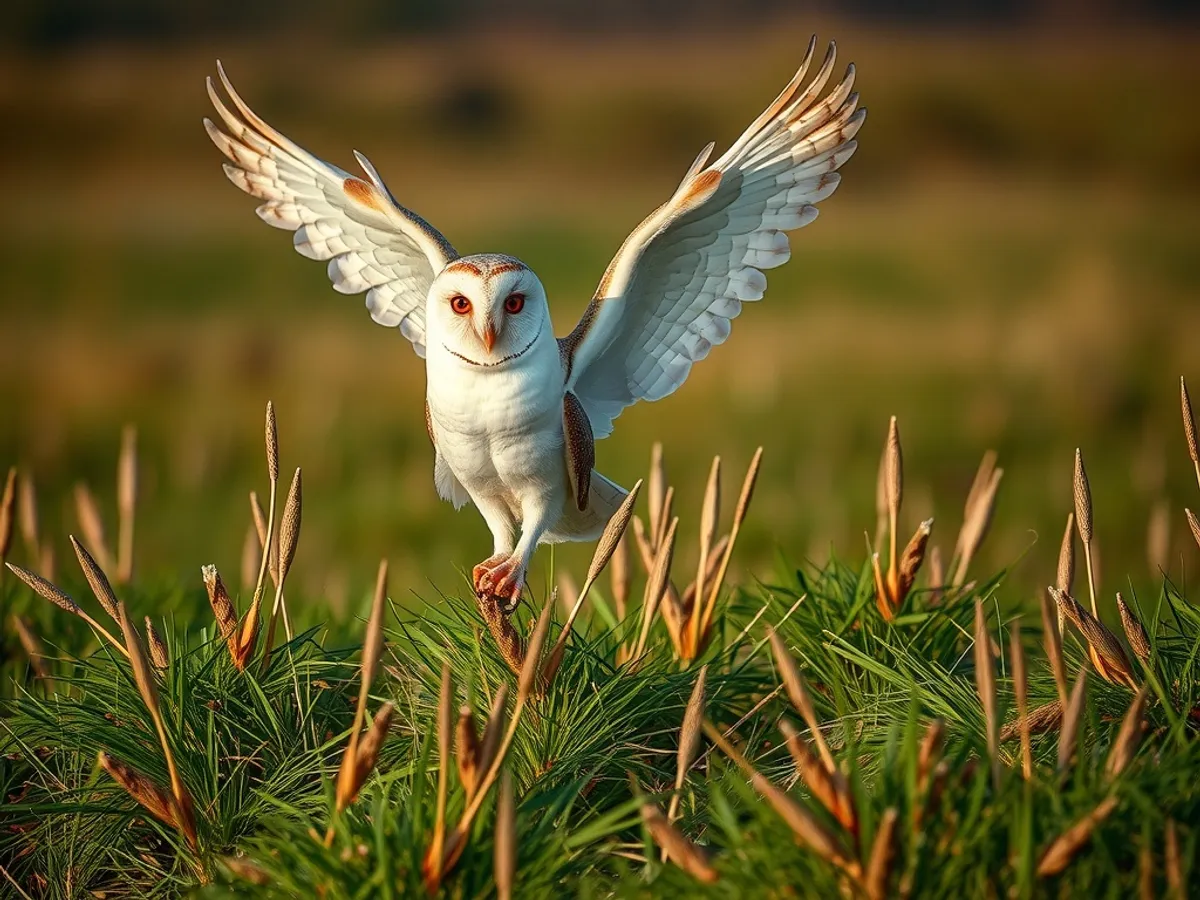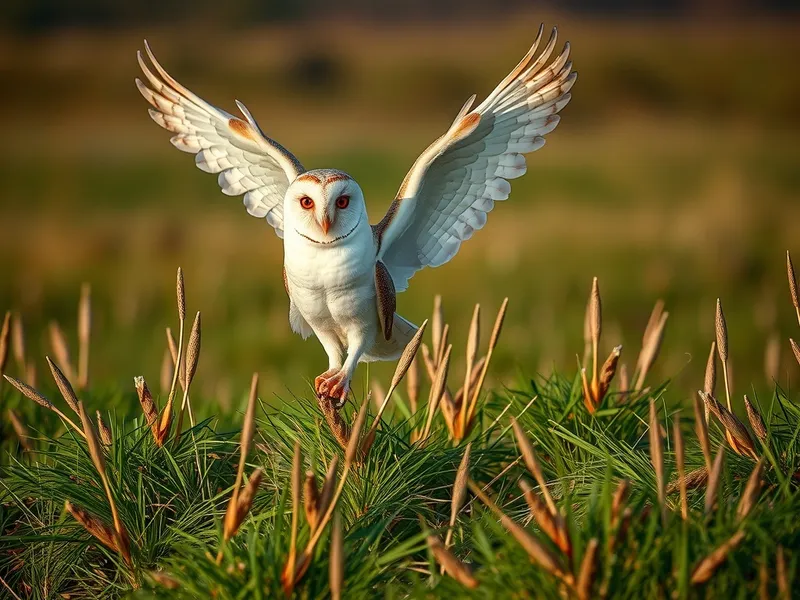
Barn Owl
Tyto alba

Meet the Barn Owl
The Barn Owl is a medium-sized, nocturnal bird known for its distinctive heart-shaped facial disc and silent flight. It has pale, golden-buff and white plumage, with long wings and a short tail, making it highly adapted for stealthy hunting at night. Barn Owls are found on every continent except Antarctica, often inhabiting rural landscapes, grasslands, and farmlands where they nest in barns, hollow trees, or old buildings. With exceptional hearing and vision, they primarily feed on small mammals such as mice and voles. Their ghostly appearance and eerie screeches have inspired myths and folklore around the world.
Classification
Bird
Habitat
Open countryside, grasslands, farmlands, and edges of woodlands
Diet
Carnivore
Lifespan
4-9 years in the wild
Conservation
Least Concern
Weight
400-700 grams
📖Fascinating Facts
Superb Hearing
Barn Owls have asymmetrical ears positioned at different heights on their heads, enabling them to pinpoint the exact location of prey even in total darkness.
Silent Hunter
Their specialized wing feathers break up turbulence and muffle sound, allowing them to fly almost silently while hunting.
Adaptable Nester
Barn Owls readily nest in man-made structures like barns, church steeples, and old silos, which is how they earned their common name.
📋Detailed Description
The Barn Owl (Tyto alba) is a medium-sized, nocturnal raptor characterized by its distinctive heart-shaped facial disc, which functions as a parabolic reflector to channel sound toward its highly sensitive ears. Adults typically measure 33–39 cm in length, with a wingspan of 80–95 cm, and weigh between 300–500 grams, with females generally larger than males. Their plumage is a striking combination of pale golden-buff on the upperparts and white to light grey on the underparts, often speckled with small dark spots, providing camouflage in open habitats. The eyes are dark and set forward, enhancing binocular vision for depth perception during nocturnal hunting. Barn Owls possess long, rounded wings and a short tail, contributing to their buoyant, silent flight, which is facilitated by specialized comb-like serrations on the leading edge of their primary feathers. They are solitary outside the breeding season, occupying territories that can span several square kilometers. The species exhibits a cosmopolitan distribution, inhabiting a variety of open landscapes including agricultural fields, grasslands, marshes, and urban peripheries. Their diet consists predominantly of small mammals, especially rodents, but can also include birds, insects, and amphibians. Barn Owls are cavity nesters, utilizing natural hollows, abandoned buildings, or nest boxes, and are known for their adaptability to human-altered environments. Their lifespan in the wild averages 4 years, though individuals may live over a decade in favorable conditions.
💡 Did you know?
A single Barn Owl family can consume over 1,000 rodents in a single breeding season, making them invaluable for natural pest control.
🔬Research & Sources
Wikipedia Summary
The barn owls, owls in the genus Tyto, are the most widely distributed genus of owls in the world. They are medium-sized owls with large heads and characteristic heart-shaped faces. They have long, strong legs with powerful talons. The term may be used to describe:The whole family Tytonidae, though this also includes the bay owls in the genus Phodilus Tyto, the largest genus of birds in Tytonidae, and particularly these species in that genus: Three species that are sometimes considered to be a single species known as barn owl or common barn owl: Western barn owl Tyto alba, from Europe, Africa, and the Middle East American barn owl Tyto furcata, from the Americas Eastern barn owl Tyto javanica, from southeast Asia and Australasia Andaman masked owl Tyto deroepstorffi endemic to the southern Andaman Islands New Caledonian barn owl Tyto letocarti, extinct, from the island of New Caledonia in Melanesia
Last Modified: 5/7/2025
🎭Behavior & Social Structure
Barn Owls are primarily nocturnal, with peak activity occurring shortly after dusk and before dawn. They hunt by quartering low over open ground, using both acute hearing and vision to detect prey. Their flight is exceptionally silent, allowing them to approach prey undetected. Prey is located mainly by sound, and studies have shown that Barn Owls can capture rodents in complete darkness by triangulating the source of rustling noises. They swallow small prey whole and later regurgitate indigestible material as pellets. Outside the breeding season, Barn Owls are largely solitary and territorial, with minimal social interaction except during courtship and nesting. They communicate through a range of vocalizations, including eerie screeches, hisses, and bill-snapping, rather than the hooting typical of many other owls. Roosting sites are reused frequently, and individuals may display site fidelity across years. Juvenile dispersal is variable, with some young traveling over 100 km from their natal site.
👶Reproduction & Life Cycle
Barn Owls are generally monogamous, with pairs forming long-term bonds that may persist for multiple breeding seasons. Courtship involves aerial displays, food offerings, and mutual preening. Breeding season timing varies with latitude and local prey abundance but typically occurs in spring or early summer in temperate regions. Females lay 4–7 white eggs (range 2–12), usually at 2–3 day intervals, in a secluded cavity or nest box. Incubation lasts 29–34 days and is performed solely by the female, while the male provides food. Chicks hatch asynchronously, resulting in size hierarchies within broods. Both parents feed the young, which fledge at 50–55 days but may remain dependent for several weeks. High reproductive output allows rapid population recovery following declines, though breeding success is closely linked to prey availability and weather conditions.
🛡️Adaptations & Survival
Barn Owls possess several remarkable adaptations for nocturnal predation. Their facial disc and asymmetrically placed ears enable precise localization of prey by sound, even under vegetation or snow. The serrated leading edges of their flight feathers disrupt airflow, rendering their flight nearly silent. Their large eyes, with a high density of rod cells, confer excellent low-light vision, though they are unable to move their eyes within the sockets and compensate with flexible necks capable of 270-degree rotation. Their long legs and toes, equipped with powerful talons, facilitate the capture of agile prey in tall grass or crops. Physiologically, Barn Owls have a high metabolic rate and efficient digestive system, allowing them to process large quantities of small prey. Behaviorally, their adaptability to nesting in artificial structures has enabled them to thrive in agricultural landscapes.
🎨Cultural Significance
Barn Owls have held a prominent place in human culture and folklore for millennia. Their ghostly appearance and nocturnal habits have inspired myths associating them with omens, death, or the supernatural in various societies, from ancient Greece to indigenous cultures in Africa and the Americas. In some traditions, they are revered as symbols of wisdom or guardianship, while in others, they are feared as harbingers of misfortune. Barn Owls have also been used in traditional medicine and as pest controllers in agricultural settings. Their image is widely employed in literature, art, and popular media, reflecting both fascination and superstition. Conservation initiatives often leverage their charismatic appeal to promote biodiversity awareness.
🔬Recent Research & Discoveries
Recent research on Barn Owls has focused on their auditory processing, revealing neural mechanisms underlying their exceptional sound localization abilities, which have informed advances in bio-inspired robotics and hearing aid technology. Genetic studies have clarified the taxonomy of the Tyto alba complex, supporting the recognition of several distinct species across its global range. Long-term ecological studies have documented the effects of landscape changes and climate variability on breeding success and population dynamics. Ongoing research is investigating the impacts of rodenticides and the effectiveness of mitigation strategies. Barn Owls are also model organisms in studies of feather microstructure and silent flight, with potential applications in aeronautical engineering.
🎥Wildlife Videos

Owl Documentary - Fascinating Facts About Owls (New Documentaries)
The vast majority of the roughly 200 species of owls are so-called true owls which possess large heads with round faces short tails ...
PL Documentary Wildlife

The Owl: Master Of The Hunt (Nature Documentary) | Natural Kingdom | Real Wild
Once nature's stealth fighter focuses, its unique first strike capability allows the owl to swoop in for the kill on swift, silent wings in ...
Real Wild

Great Horned Owl on the Hunt | Nat Geo Wild
#NatGeoWILD #Owls #Birds About National Geographic Wild: National Geographic Wild is a place for all things animals and for ...
Nat Geo Animals

Graceful Barn Owl Hunting in the Daytime | BBC Earth
An Unexpected Wilderness Away from the tame landscape of suburban Essex, with its car parks and roads, Natural World ...
BBC Earth

Wild America | S2 E7 Owls: Lords of Darkness | Full Episode HD
One of the best episodes IMO. The photography is stunning throughout with beautiful captures of owls (some of the most gorgeous ...
Wild America Animal Channel

Mesmerising Owl Moments | BBC Earth
Welcome to BBC EARTH! The world is an amazing place full of stories, beauty and natural wonder. Here you'll find 50 years worth ...
BBC Earth
🌍Habitat Information
The Barn Owl typically inhabits Open countryside, grasslands, farmlands, and edges of woodlands environments. Barn Owls have adapted to their environments with specialized features and behaviors.
Primary Habitat:
Open countryside, grasslands, farmlands, and edges of woodlands
More detailed habitat information will be available soon.
🛡️Conservation Status
The Barn Owl is currently classified as Least Concern. Conservation efforts are crucial for preserving this species for future generations.
Common Threats:
- 🏠Habitat loss and fragmentation
- 🌡️Climate change impacts
- 🎯Hunting and poaching
- 🏭Human-wildlife conflict
⚠️Threats & Conservation Challenges
While the Barn Owl is classified as Least Concern globally, populations face significant regional threats. Habitat loss due to agricultural intensification, removal of hedgerows, and conversion of grasslands reduces prey abundance and nesting sites. Secondary poisoning from rodenticides is a major concern, as owls ingest contaminated prey. Road mortality is common, particularly where roads intersect hunting grounds. Climate change may impact prey cycles and breeding success. In some areas, persecution and loss of traditional nesting sites in old buildings have contributed to local declines. Conservation efforts, including nest box programs and reduction of rodenticide use, have proven effective in supporting populations. Long-term monitoring indicates stable or increasing trends in some regions, but declines persist where threats are unmitigated.
🔬Scientific Classification
Scientific Name
Tyto alba
Classification Hierarchy
🔍 About Taxonomic Classification
Taxonomic classification is a hierarchical system used by scientists to classify and organize living organisms based on shared characteristics and evolutionary relationships.
The system moves from broad categories (Kingdom) to increasingly specific ones, with each animal's scientific name typically consisting of its Genus and species.
📝Community Notes
Share your observations and insights about the Barn Owl with our community of wildlife enthusiasts.
Join Our Community
Sign in to share your observations and connect with fellow wildlife enthusiasts.
Sign In to ContributeNo community notes yet
Be the first to share your observations about the Barn Owl!
Explore Barn Owl
Select a tab above to learn more about this amazing animal.
📸Photo Gallery
No photos available for this animal yet.
🌟Discover More Wildlife
Continue your journey of discovery with more fascinating animals from our database
